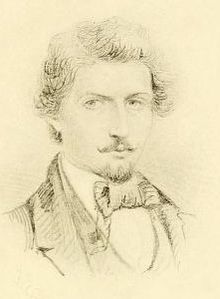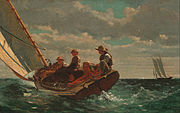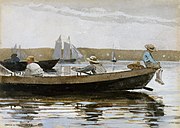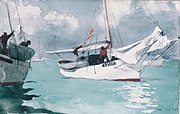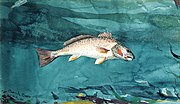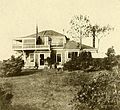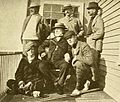Winslow Homer
Winslow Homer (born February 24, 1836 in Boston , Massachusetts , † September 29, 1910 in Scarborough , Maine ) was an American draftsman and painter .
Youth and education
Winslow's father, Charles Savage Homer, married to Henrietta Maria Benson, daughter of John and Sarah (Buck) Benson, born 1809 in Bucksport, Maine, co-owned a hardware store called Homer, Gray & Co., importers of hardware in Boston . When gold was discovered in California in 1849, his father sold his stake in the company and went to California for the Fremont Mining Company. He loaded a ship in Boston that was sailing to San Francisco via Cape Horn. He himself took the shorter route across the Isthmus of Panama. He was away from home for a total of two years, but the company was unsuccessful. Winslow was the second born of three sons. His older brother Charles Savage Homer Jr. was two years older and his younger brother Arthur B. was born five years after Winslow. In 1842 the family moved to Cambridge, where Winslow grew up. The parents' intention was to give their three boys a good education. But only Winslow's older brother, Charles S. Homer Jr, made it to college and Harvard, where he graduated with an SB from Lawrence Scientific School in 1855.
Winslow attended Washington Grammar School, on Brattle Street, near Harvard Square in Cambridge, and began drawing at an early age. His parents encouraged him and his father once brought him a complete set of lithographs by Julian from Paris, which included heads, ears, noses, eyes, faces, houses and trees - everything a young draftsman would enjoy.
In 1855, his father saw an advertisement from John Bufford, a Boston lithographer looking for an apprentice with a talent for drawing. After a probationary period of two weeks, Bufford took him on as an apprentice and even waived the usual tuition fee of $ 300. Bufford mainly decorated sheet music for the Oliver Ditson company in Boston. Winslow's greatest work was portraits of the entire Massachusetts Senate.
When his apprenticeship ended after two years - on his 21st birthday on February 24, 1857 - he rented a room on Winter Street, in the building where the magazine "Ballou's Pictorial," was to which he was soon to be located sold some drawings. In 1858 he began sending his drawings to Harper & Brothers, in New York, who had just started Harper's Weekly . Because he had no training as a painter, he was not yet considered a great artist at the time. His earliest work at Harper's Weekly was to copy Mathew Brady's photos to create woodcuts suitable for the newspaper's printing.
For the next 17 years his main source of income was the sale of drawings to weekly magazines such as Harper's Weekly, Frank Leslie's Illustrated Weekly Newspaper and Appleton's Journal .
Freelance draftsman work
In 1859 he moved to New York City . In 1861 he moved into a room in the New York University building, where he lived until 1872 in a tower room that had access to a flat roof - and therefore daylight. He then moved to the Tenth Street Studio Building in Greenwich Village, the outstanding artist address of the time. The building was built in 1858 by Richard Morris Hunt . He lived in the 25 studios with his artist colleagues, almost all of whom were members of the National Academy of Design. B. Albert Bierstadt , NA; William Merritt Chase , NA; John La Farge NA; Frederic Church , NA; He stayed here until he left for England.
Homer enrolled in the National Academy School for the 1859–60 semester and was given the unusual privilege of being directly admitted to the Life class, with no qualification in the Antique Class (copying of statues ) had to prove. 1860–1861 and 1863–64 he enrolled again for the semesters of evening school under Thomas Seir Cummings ( Founder 1826 ). He also took private lessons on Saturdays in 1861 from Frederic Rondel, who taught him how to use his brush and hold the palette. He continued to provide numerous illustrations for books and magazines. A change in Homer's work could already be seen during 1861 when he was hired to record Abraham Lincoln's inauguration in Washington DC . In 1865, Winslow Homer was elected a member of the National Academy.
When the American Civil War broke out , Homer made several trips to the Virginia War Front between 1861 and 1865 . Armed with a letter from Fletcher Harper , the editor of Harper's Weekly , identifying him as a "special artist" (now likely press card), Homer was able to move through the front lines and gain access to the Army from the Potomac to get. In early April 1861, he was in Alexandria and witnessed the army's embarkation aboard the steamer that would take them to the peninsula near Richmond in preparation for General George B. McClellan's long-awaited spring offensive. A drawing he made of the Union's 6th Pennsylvania Cavalry Regiment - the Union's only regiment to carry lances - testified to Homer's eye for the unusual and the dramatic.
He was given a Virginia military pass issued to Winslow Homer April 1, 1862, from the office of the commanders of the Military Police in Washington. Homer sailed with the army on the Potomac River towards Fort Monroe and Yorktown in the Tidewater region. Supplied with pen and ink, pencil and white paper, Homer stayed with the army for about two months. During this time the siege of Yorktown took place and the Battle of Fair Oaks was fought. Except for what is reproduced in his drawings, Homer never made a record of his movements. But correspondence from an acquaintance, Lieutenant Colonel Francis Channing Barlow of the 61st New York Infantry, indicated that Homer was at the camp at least temporarily at 61st. Homer himself subtly refers to this connection in at least two of his works, in which the number "61" appears on a backpack.
Based on evidence in two other works, The Briarwood Pipe (1864) and Pitching Horseshoe (1865) - Homer came into contact with the New York Fifth Infantry Regiment, also known as "Duryee Zouaves". Known as "the best and most disciplined regiment" in General McClellan's army, they wore the distinctive Zouave uniforms, bright red trousers, red fez, and dark blue collarless jackets. Homer made sketches of these colorfully dressed soldiers, fully aware that this work had potential for "future greatness".
Many of the scenes he painted from the camp illuminate the physical and physical plight of the common soldiers. He received national acclaim for these early works, both for the expressiveness and the technique of his paintings. "Home, Sweet Home" was exhibited in New York in 1883 and quickly found a buyer. The title of the picture refers to a song that was often played by the military band pictured in the background. The current "home" of the soldiers is the camp, in which a kettle is on the smoking fire and rusks are on a tin plate. Homer also had to cook and wash when he was at the front, and with intentional irony he called his painting "Sweet Home".
In Paris
He then painted more oil paintings , Prisoners from the Front (1866) attracted widespread attention. This picture of him was exhibited at the Paris Exhibition of 1866. He took this as an opportunity to travel to Paris in 1867 . There was little contact with members of the French avant-garde, but common interests with Homer, their fascination for series pictures, and their desire to capture the special light in outdoor painting and to integrate it in flat and simple forms (reinforced by their appreciation of Japanese design principles ) as well as a free brushwork he got to know here. Apart from two drawings of balls and one from the Louvre , nothing is known about his stay in Paris.
Homer's post-war works show life in the country and in the seaside resorts. His palette is bright in color and his paintings have a freer brushstroke and an interest in the effects of light. His favorite motif in the 1870s is the lonely female figure, often lost in thought.
Homer began in 1873 watercolors to paint and presented annually in the Society of Watercolor Painters and the Brooklyn Art Association and the National Academy his genre paintings , which in their realism by striking characteristic of the figures and original punchlines , but also by excessive boldness and breadth of treatment, which is often detrimental to the details.
In the Adirondacks
Homer first came to Keene Valley, which had become an artist colony after the Civil War, in 1874 with two of his fellow painters, Eliphalet Terry and John Lee Fitch. At that time it was just a clearing in the wilderness with a farm owned by the Baker family who settled here in 1854. Terry painted a picture of the clearing in 1859. Baker's daughter Juliette kept a diary from 1865 to 1886 so that Homer's visits are recorded. In September 1870 Homer was here again. Other painters here included Roswell Shurtleff, Arthur and Ernest Parton, Carleton Wiggins, George McCord, Alexander Helwig Wyant, and a few others. Homer's most famous oil paintings from the period were “Adirondack Lake” 1870 and “The Two Guides”. On December 24, 1870, he published his drawings “The Woodcut” and “Trapping in the Adirondacks” in “Every Saturday”.
After 1886, the year the land was bought to the North Woods Club, of which Charles and Winslow Homer were founding members, there is a club registry with records of Homer's visits, all in its script. The last entry is dated June 25, 1908, in shaky script, because he suffered a stroke in the spring. Homer notes in it that he shot a bear.
While his painting colleagues were painting a panorama landscape with a lake and mountains, Homer always placed a human figure in the foreground against an imposing background.
Winslow and his brother Charles went mountaineering and camping as teenagers. Now they were avid fly fishers. They went on many fishing trips together, in warm weather to the “North Woods Club” in the Adirondacks and the exclusive “Torelli Fish and Game Club” in the province of Québec . In the winter months they were found on the Saint John River in Florida or later in the Bahamas . Fortunately, Homer was able to combine his passion with his art. He was aware that his watercolors about fishing would only be of interest to certain male customers who were also avid anglers.
Intermittently, Homer came to the Adirondacks for over 38 years, hunting, fishing, and painting.
The Two Guides
Today we know that the figures in the painting represent the two mountain guides Orson "Old Mountain" Phelps, the smaller, older and well-known guide at the time, and Charles Monroe Holt, the younger, larger guide. Both were from Keene Valley, NY
When the picture was first exhibited at the National Academy of Design's annual exhibition in 1878, it was not well received. The critics found the painting "sloppy, negligent, imperfect" and so it disappeared for almost 15 years.
During those years, however, Homer had developed and Impressionism had reached America. When "The Two Guides" was shown again in 1890, time and tastes had changed. The critics - some who had condemned it before - were now full of praise.
Thomas B. Clarke, a collector of Homer's paintings, believed it was worth it and bought the painting for about $ 200 to $ 1000. Clarke later sold the painting to Robert Sterling Clark for a verifiable $ 10,000 for believing Homer was the greatest American artist.
In England
In 1881 he traveled to England on his second and last trip abroad. After a short stay in London , he settled in Cullercoats, a fishing village near Tynemouth on the North Sea, and stayed there from spring 1881 to November 1882. He became sensitive to the strenuous and courageous life of its residents, especially the Women he depicted carrying baskets and cleaning the fish, mending the nets, and most aptly standing at the edge of the water waiting for their husbands to return. When the artist returned to New York, he and his art had changed a lot.
In the summer of 1883 he stayed in Atlantic City ( New Jersey on) when he could watch the rescue crews. This resulted in two important oil paintings. The first was The Life Line, shown at the Academy’s annual exhibition in 1884, which surprised Homer's new, vigorous way of painting. The painting was purchased by Catherine Lorillard Wolfe for $ 2,500 during the reception at the exhibition. This purchase did not go unnoticed, especially since it was the first American work to be included in Miss Wolf's collection. The second painting, Undertow, was also a huge hit when it was shown at the National Academy in 1887.
Homer's parents had lived in New York since the winter of 1872. A few weeks after Homer's triumph in the annual exhibition of 1884, his mother died. After her funeral in Boston, Homer immediately drove with his father to Prouts Neck, where his brother Arthur lived. His father did not return to New York, but lived in a hotel in Boston for the winter and in Prouts Neck for the summer. Homer no longer needed to be in New York to check on his parents or to establish his reputation as a painter. Although he visited New York and Boston more often, he made Prouts Neck and his studio his home at the end of 1884.
Prouts Neck, Maine
Winslow's brother Arthur B. had discovered the Prouts Neck peninsula in Maine (in Scarborough) on his honeymoon in 1875 and from that year on he regularly spent the summer months there. Later joined by his father and brother Charles. Winslow had visited her before he decided to build a cottage and studio to settle in Prouts Neck forever. The Homers bought up most of the land on the lake side and set about developing the place into a vacation spot, with the result that there were sixty-seven houses and seven hotels on Prouts Neck in 1910.
In 1883 Homer moved to Prouts Neck and lived on his family's estate in the former coach house converted into a studio by the architect John Calvin Stevens - only seventy-five meters from the sea until the end of his life.
Almost anyone else would have maintained a city apartment to meet other artists or to see how the scene was developing. But not Homer. From 1888 he stopped exhibiting or paid very little attention to the invitations he received. Most of his pictures that were exhibited afterwards belonged either to art dealers or collectors. He would occasionally leave his refuge to take part as a judge at an exhibition. But the younger artists were no longer known.
He lived alone, cooked for himself - pretty well it is said - and employed a man who came every morning to do the housework. He enjoyed doing handicrafts, building walls and a dog house, and gardening. He had a garden with old flowers and a vegetable garden. He once grew tobacco with the intention of making his own cigars. In such a place Homer could hardly live as a hermit - as legend attributes him - but he effectively sealed himself off from professional society and with increasing age fewer and fewer people were allowed into his studio. When Prouts Neck got too full of summer guests for him, he fled to Florida or the Bahamas and returned in March with wonderful watercolors.
Inspired by the rugged beauty of the Maine coast, Homer's art changed dramatically in theme and mood. He created monumental sea stories and seascapes, he examined the struggle of man to life and death against the sea and the elemental power of nature. Painted with strong brushwork and carefully observed realism, these late paintings capture the titanic power of the waves that hit the rocky coast at different times of the year and climatic conditions.
In 1893 he exhibited his oil painting "Emergency Signal" for the first time in the Portland Society of Art (later the Portland Museum of Art ). In the same year he visited Québec for the first time and exhibited at the World's Fair in Chicago . The sensation of the exhibition was that the great Fontaine Frederick William MacMonnies was illuminated by light in the evening. Homer captured this moment in his painting "The Fountains at Night, World's Columbian Exposition", with the fountain with the horses and a gondola in the foreground.
In 1865 he was elected a member of the National Academy of Design (NA) and in 1905 the American Academy of Arts and Letters .
He was a member of the Century Association (Ges. Für Kunst und Literatur) from 1865 until his death in 1910.
Homer died in 1910 at the age of 74 in his Prouts Neck studio in the presence of his two brothers. He was buried in Mount Auburn Cemetery in Cambridge, Massachusetts.
In 1996 the Winslow Homer Studio became a National Historic Landmark .
On January 31, 2006, the Portland Museum of Art bought the studio from Charles “Chip” Homer Willauer, who Winslow was a great-grand-uncle, for approximately $ 1.9 million. After the renovation work, the studio was opened to the public on September 25, 2012. If you step onto the balcony of his studio today, you can see the house in which his father Charles Homer Sr. lived and later also his brother Charles Jr. and his wife Mattie, who was very fond of Homer.
Postage stamps
In 2010 the US Post Office Department honored Winslow Homer with the issue of a 44-cent postage stamp depicting his painting " Boys in a Pasture ". This was Homer's third time on a US postage stamp. 1962 was the first time with " Breezing Up" (The wind freshen up). The 1998 stamp featured his painting " The Fog Warning ".
Painting selection
Croquet Scene, 1866
Collection of watercolors in the Metropolitan Museum of Art , New York (selection)
From the family album
Literature selection
- Thomas Andrew Denenberg: Weatherbeaten: Winslow Homer and Maine. Yale University Press, New Haven 2013, ISBN 978-0-300-18442-6 .
- Marc Simpson: Winslow Homer & the Clark (Sterling & Francine Clark Art Institute) Publisher: Yale University Press 2013 ISBN 978-0-3001-9194-3 .
- Sophie Levy: Winslow Homer: Poet of the Sea . Publisher: University of Chicago Press; Tra edition May 2006 ISBN 978-0-9321-7150-4 .
- Tony Harrison: Winslow Homer in England . Publisher: PR Hornby 2004 ISBN 978-0-9636-4142-7 .
- Winslow Homer . by Franklin Kelly (Author), Jr. Nicolai Cikovski (Author), Judith Walsh (Contributor), Charles Brook (Contributor) Publisher: Yale University Press 1995 ISBN 978-0-3000-6555-8 .
- Lloyd Goodrich: Winslow Homer . Published for the Whitney Museum of American Art by The Macmillan Company, New York 1944
- Recollections of an intimate Friendship by John W. Beatty - page 207 in: Lloyd Goodrich, 1944
- Kenyon Cox: Winslow Homer . "Three hundred copies of this book on Dutch handmade paper privately printed by Frederic Fairchild Sherman." New York, 1914
- William Howe Downes: The life and works of Winslow Homer . Publisher: Houghton Mifflin Boston; New York 1911
- William Howe Downes: Twelve great artists . - Winslow Homer, page 105 - Publisher: Little, Brown and company, Boston 1900
- A painter of the sea . Two pictures by Winslow Homer. THE CENTURY MAGAZINE No. September 5, 1899. By William A. Coffin.
- Mrs. Schuyler Van Rensselaer: Six portraits: Della Robbia, Correggio, Blake, Corot, George Fuller, Winslow Homer Publisher: Houghton, Mifflin and company Boston and New York, 1889
Web links
- Winslow Homer at The Athenaeum
- Paintings of Winslow in the Metropolitan Museum of Art
- Winslow Homer Paintings - Overview
- Winslow Homer: Midsummer Night 1890 Oil on canvas H. 76.7; B. 102 cm RMN-Grand Palais (Musée d'Orsay)
- Biography of Winslow Homer in 2015 Encyclopædia Britannica, Inc.
- Paintings by Winslow Homer at the Museum of Fine Art, Boston
- VISUAL CHRONOLOGY OF REPRESENTATIVE WORKS BY WINSLOW HOMER in the National Gallery of Art
- Winslow Homer in the Adirondacks: an exhibition of paintings, August 15-September 15, 1959 in the Adirondacks Museum. Lithographed by The Widtman Press, Inc.
- Winslow Homer and the New England coast . Exhibition Whitney Museum of American Art November 9, 1984-January 9, 1985
- VISIT The Winslow Homer Studio , Purchased by the Portland Museum of Art in 2006
Individual evidence
- ↑ Ballou's pictorial drawing room companion Volume: 17, 1859
- ^ New York's Famed Tenth Street Studio Building
- ↑ Evoking the World of Winslow Homer The New York Times Published: August 17, 1997
- ↑ Biography in National Academy ( Memento from April 4, 2015 in the Internet Archive )
- ↑ Abraham Lincoln's Inauguration Winslow Homer Artwork
- ^ Nationalacademy.org: Past Academicians "H" / Homer, Winslow NA 1865 ( Memento April 2, 2015 in the Internet Archive ) (accessed June 26, 2015)
- ^ Drawing, General McClellan's Sixth Cavalry Regiment, Embarking at Alexandria for Old Point Comfort. April 2, 1862 - Graphite, brush and gray wash on cream paper. Gift of Charles Savage Homer, Jr. 1912
- ↑ Where is "Tidewater" in Virginia?
- ↑ Homer's Briarwood Pipe
- ↑ / Winslow Homer's Civil War - Pitching Horseshoes - The Harvard Gazette
- ↑ Duryee's Zouaves: The 5th New York Volunteer Infantry ( September 15, 2002 memento )
- ↑ Home, Sweet Home, ca.1863 ( Memento from March 4, 2015 in the Internet Archive )
- ↑ “Prisoners from the Front” in the MET Museum - the battlefield of Petersburg, Virginia, is shown in the background
- ^ Art-Students and Copyists in the Louvre Gallery, Paris (1868) - The Brooklyn Museum
- ^ Encyclopedia entry for "Homer". Meyers Großes Konversations-Lexikon, Volume 9. Leipzig 1907, p. 518
- ↑ The Painter Eliphalet Terry Fishing from a Boat, painted by Homer Winslow in 1874
- ↑ John Lee Fitch “Mountain Lake” Christies auction Sale 1488, March 2005
- ↑ Adirondack Lake
- ^ Winslow Homer Drawing: Fisherman in Quebec, Canada, 1895 . Gift of Charles Savage Homer, Jr. 1912 to The Smithsonian's Cooper-Hewitt, National Design Museum, in New York City
- ↑ American Impressionism
- ^ Catalog of the Thomas B. Clarke Collection of American Pictures Exhibition October 15 to November 28, 1891 in the Pennsylvania Academy of Fine Arts
- ^ Winslow Homer's 'Two Guides' led impressionist movement in America. By Chris Newbound. Published: The Berkshire Eagle, December 27, 2012
- ↑ number 12 Bank Top, Cullercoats, used as a studio by Winslow Homer ( Memento of March 4, 2016 in the Internet Archive )
- ^ Winslow Homer in England ( Memento from December 25, 2014 in the Internet Archive )
- ^ The Cullercoats paintings in photographs, page 279 ff Lloyd Goodrich: Winslow Homer. Published for theWhitney Museum of American Art by The Macmillan Company, New York 1944
- ^ John Calvin Stevens in the New England Historical Society
- ↑ Interactive map of Prouts Neck, Maine - shows the places where Winslow Homer painted outdoors
- ^ Winslow Homer: The Fountains at Night, World's Columbian Exposition, 1893 Illuminated by Electric Light
- ^ Members: Winslow Homer. American Academy of Arts and Letters, accessed April 4, 2019 .
- ^ Century Club
- ↑ Prouts Neck, Me., Site of Winslow Homer's studio, was the source for his unsentimental depictions of the sea and seafaring. By GERALDINE FABRIKANT The New York Times, Published: September 2, 2009
- ↑ The boys in the pasture
- ↑ About This Artwork - Winslow Homer - Croquet Scene. The Art Institute of Chicago , accessed May 1, 2012 .
- ↑ Winslow Homer's mater pieces
- ↑ About This Artwork - Winslow Homer - After the Hurricane. The Art Institute of Chicago , accessed May 1, 2012 .
| personal data | |
|---|---|
| SURNAME | Homer, Winslow |
| BRIEF DESCRIPTION | American draftsman and painter |
| DATE OF BIRTH | February 24, 1836 |
| PLACE OF BIRTH | Boston , Massachusetts |
| DATE OF DEATH | September 29, 1910 |
| Place of death | Prouts Neck , Scarboro, Maine |
